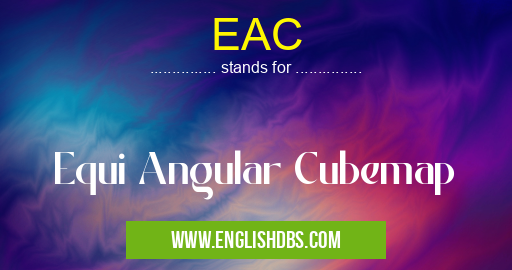What does EAC mean in UNCLASSIFIED
EAC (Equi Angular Cubemap) is a specialized type of cubemap that is used in computer graphics and 3D rendering. It is a texture mapping technique that involves projecting a scene onto the faces of a cube, resulting in a six-sided texture map that can be used to represent the environment around a camera.

EAC meaning in Unclassified in Miscellaneous
EAC mostly used in an acronym Unclassified in Category Miscellaneous that means Equi Angular Cubemap
Shorthand: EAC,
Full Form: Equi Angular Cubemap
For more information of "Equi Angular Cubemap", see the section below.
Key Features of EAC
- Equidistant Projection: The scene is projected onto the cube faces using an equidistant projection, which preserves the angles between objects in the scene.
- Six-Sided Texture Map: The EAC consists of six square textures, one for each face of the cube.
- Seamless Transitions: The edges of the textures are blended together to create seamless transitions between the cube faces.
- High-Quality Rendering: EACs provide a high-quality representation of the environment, as they capture the scene from multiple angles.
Applications of EAC
EACs are primarily used in real-time rendering applications, such as video games and virtual reality. They are particularly useful for creating immersive environments that can be explored from different perspectives. EACs can also be used in offline rendering for creating realistic still images.
Benefits of EAC
- Reduced Memory Consumption: Compared to other cubemap formats, EACs require less memory to store.
- Improved Performance: EACs can be rendered more efficiently than other cubemap formats, leading to improved performance in real-time applications.
- Versatile Use: EACs can be used with a variety of rendering techniques, including physically based rendering (PBR).
Essential Questions and Answers on Equi Angular Cubemap in "MISCELLANEOUS»UNFILED"
What is an EAC (Equi Angular Cubemap)?
An EAC (Equi Angular Cubemap) is a specific type of cubemap that uses an equirectangular projection to represent a panoramic image. This projection maps the image onto the six faces of a cube, with each face representing a different view of the scene. EACs are commonly used in computer graphics and virtual reality applications due to their ability to provide a seamless and immersive viewing experience.
What are the benefits of using an EAC over other cubemap formats?
EACs offer several advantages over other cubemap formats:
- Seamless Projection: The equirectangular projection used in EACs results in a seamless transition between the different faces of the cubemap, eliminating any visible seams or artifacts.
- Wide Field of View: EACs provide a wide field of view, encompassing 360 degrees horizontally and 180 degrees vertically. This allows for a more immersive and realistic viewing experience.
- Reduced Distortion: Compared to other cubemap formats, EACs exhibit less distortion, especially near the edges of the image. This results in a more accurate and natural representation of the scene.
How are EACs used in practical applications?
EACs find applications in various fields, including:
- Computer Graphics: EACs are widely used in computer graphics for creating panoramic images and virtual environments. They provide a convenient and efficient way to represent complex scenes with high levels of detail.
- Virtual Reality: EACs are essential for creating immersive virtual reality experiences. They provide a realistic and seamless way to render panoramic views, allowing users to explore virtual environments in a highly engaging manner.
- Image Stitching: EACs are used in image stitching techniques to combine multiple images into a single panoramic image. The equirectangular projection ensures that the stitched image has a consistent and seamless appearance.
Final Words: EAC (Equi Angular Cubemap) is a powerful texture mapping technique that provides high-quality environmental representation in computer graphics. Its equidistant projection, six-sided texture map, seamless transitions, and efficiency make it an ideal choice for real-time rendering and virtual reality applications.
EAC also stands for: |
|
| All stands for EAC |
